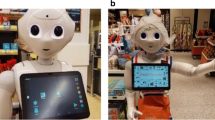Abstract
The story from the museum may not be read by visitors, who come with their own knowledge and understanding and read a different story in the animals. The visitors read a story which makes sense to them and builds on what they already know and interests them.
Increasingly, robotics models are being used in natural history museums, science centers, and zoos to attract visitors and tell some kind of story. What do the visitors actually talk about when looking at such robotic animals? The visitors reported on in this paper were primary school groups and families. Do they talk about similar things at the same exhibits, even though the schools visit for educational purposes and the families of their free choice in their leisure time? Furthermore, within school groups, do different subgroups respond in a different way, gauged by the content of their conversations, to similar robotics? This paper studies the conversational content of primary school and family groups at two different robotics dinosaur exhibits in the Natural History Museum, London. One of the exhibits is no longer on display. These verbal responses were analyzed through using a systemic network. Results indicate that visitors commented on a very simple story told through the design of the exhibit and the movements of the specimens. Visitors also noticed the salient features of the animatronics models as reptiles.
Similar content being viewed by others
References
Birney, B. (1988). Criteria for successful museum and zoo visits: Children offer guidance.Curator, 31(4), 292–316.
Bliss, J., Monk, M., & Ogborn, J. (1983).Qualitative analysis for educational research. London: Croom Helm.
Brown, C. A. (with Oliver, A., & Bazley, M.). (1997). Making the most of school visits: Interactions between school helpers and children in a hands-on science gallery.Journal of Education in Museums, 18, 24–25.
Dale, E. (1954).Audio-visual methods in teaching. New York: The Dryden Press.
Department for Education and Employment (DfEE). (1995).Key stages 1 and 2 of the national curriculum. London: HMSO.
Driver, R., Guesne, E., & Tiberghien, A. (Eds.). (1985).Children’s ideas in science. Buckingham, UK: Open University Press.
Gelman, S. A. (1988). The development of induction within natural kinds and artifact strategies.Cognitive Psychology, 20(1), 65–95.
Heyman, G. D., & Gelman, S. A. (2000). Pre-school children’s use of trait labels to make inductive inferences.Journal of Experimental Child Psychology, 77, 1–19.
Kellert, S. (1985). Attitudes towards animals: Age-related development among children.Journal of Environmental Education, 16(3), 29–39.
Klahr, D. (2000).Exploring science: The cognition and development of the discovery processes. Cambridge: MIT Press.
Lemke, J. (1990).Talking science: Language, learning and values. Norwood, NJ: Ablex Publishing Corporation.
Marshdoyle, E., Bowman, M. L., & Mullins, G. W. (1982). Evaluating programmatic use of a community resource: The zoo.Journal of Environmental Education, 13(4), 19–26.
Peart, B. (1984). Impact of exhibit type on knowledge gain, attitudes and behaviour.Curator, 27(3), 220–237.
Ramey-Gassert, L. (1996). Same place, different experiences: Exploring the influence of gender on students’ science museum experiences.International Journal of Science Education, 18(8), 903–912.
Serrell, B. (1997). Paying attention: The duration and allocation of visitors’ time in museum exhibitions.Curator, 40(2), 108–125.
Solomon, J. (1997). Girls’ science education: Choice, solidarity and culture.International Journal of Science Education, 19(4), 407–417.
Tomkins, S., & Tunnicliffe, S. D. (2001). Looking for ideas: Observations, interpretation and hypothesis-making by twelve-year-old pupils undertaking science investigations.International Journal of Science Education, 23(8), 791–813.
Tunnicliffe, S. D. (1995).Talking about animals: Studies of young children visiting zoos, a museum, and a farm. Unpublished PhD thesis, King’s College, London.
Tunnicliffe, S. D. (1996a). Conversations within primary school parties visiting animal specimens in a museum and zoo.Journal of Biological Education, 30(2), 130–141.
Tunnicliffe, S. D. (1996b). Talking science at animal collections.Primary Science Review, 45, 24–27.
Tunnicliffe, S. D. (1996c). The relationship between pupils’ ages and the content of conversations generated at three types of animal exhibits.Research in Science Education, 26(4), 461–480.
Tunnicliffe, S. D. (1997). The effect of the presence of two adults—chaperones or teachers—on the content of the conversations of primary school groups during school visits to a natural history museum.Journal of Elementary Science Education, 9(1), 49–64.
Tunnicliffe, S. D. (1998). Boy talk: Girl talk—Is it the same at animal exhibits?International Journal of Science Education, 20(7), 795–811.
Tunnicliffe, S. D. (1999). It’s the way you tell it! What conversations of elementary school groups tell us about the effectiveness of animatronics animal exhibits.Journal of Elementary Science Education, 11(1), 23–37.
Tunnicliffe, S. D., Lucas, A. M., & Osborne, J. F. (1997). School visits to zoos and museums: A missed educational opportunity?International Journal of Science Education, 19(9), 1039–1056.
Watson, J. R., Goldsworthy, A., & Wood-Robinson, V. (1999). What is not fair with investigations.School Science Review, 80(292), 101–106.
Author information
Authors and Affiliations
Corresponding author
Rights and permissions
About this article
Cite this article
Tunnicliffe, S.D. Conversations of family and primary school groups at robotic dinosaurs in a museum? What do they talk about?. J Elem Sci Edu 20, 17–33 (2008). https://doi.org/10.1007/BF03174706
Accepted:
Issue Date:
DOI: https://doi.org/10.1007/BF03174706




